An anthem is a musical composition of celebration, usually used as a symbol for a distinct group, particularly the national anthems of countries. Originally, and in music theory and religious contexts, it also refers more particularly to short sacred choral work and still more particularly to a specific form of liturgical music. In this sense, its use began c. 1550 in English-speaking churches; it uses English language words, in contrast to the originally Roman Catholic 'motet' which sets a Latin text.

"Poland Is Not Yet Lost", also known as the "Dąbrowski's Mazurka", and the "Song of the Polish Legions in Italy", is the national anthem of Poland.
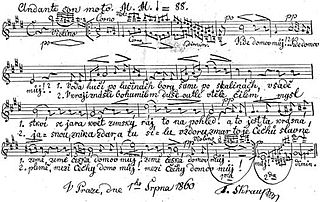
"Kde domov můj" is the national anthem of the Czech Republic, written by the composer František Škroup and the playwright Josef Kajetán Tyl.
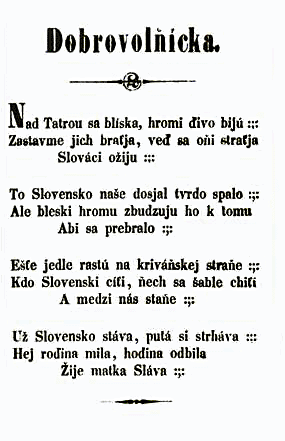
"Nad Tatrou sa blýska" is the national anthem of Slovakia. The origins of it are in the Central European activism of the 19th century. Its main themes are a storm over the Tatra mountains that symbolized danger to the Slovaks, and a desire for a resolution of the threat. It used to be particularly popular during the 1848–1849 insurgencies.

The pan-Slavic colors—blue, white and red—were defined by the Prague Slavic Congress, 1848, based on the symbolism of the colors of the flag of Russia, which was introduced in the late 17th century. Historically, many Slavic nations and states adopted flags and other national symbols that used some combination of those three colors. Slavic countries that use or have used the colors include Russia, Yugoslavia, Czechoslovakia, Czech Republic, Slovakia, Croatia, Serbia and Slovenia, whereas Belarus, Bosnia and Herzegovina, Bulgaria, Montenegro, North Macedonia, Poland and Ukraine use different color schemes.
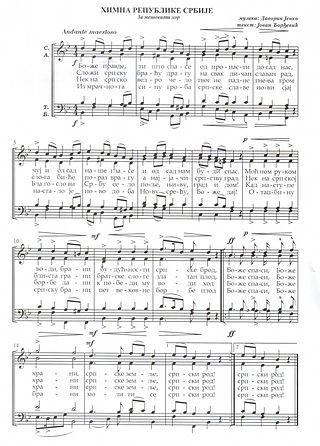
"Bože pravde" is the national anthem of Serbia, as defined by the Article 7 of the Constitution of Serbia. "Bože pravde" was adopted in 1882 and had been the national anthem of the Kingdom of Serbia until 1919 when Serbia became a part of the Kingdom of Serbs, Croats and Slovenes. It was re-adopted as the national anthem at first by the parliamentary recommendation in 2004 and then constitutionally sanctioned in 2006, after Serbia restored its independence.

Yugoslavs or Yugoslavians is an identity that was originally designed to refer to a united South Slavic people. It has been used in two connotations: the first in a sense of common shared ethnic descent, i.e. panethnic or supraethnic connotation for ethnic South Slavs, and the second as a term for all citizens of former Yugoslavia regardless of ethnicity. Cultural and political advocates of Yugoslav identity have historically ascribed the identity to be applicable to all people of South Slav heritage, including those of modern Bosnia and Herzegovina, Croatia, Montenegro, North Macedonia, Serbia, and Slovenia. Although Bulgarians are a South Slavic group, attempts at uniting Bulgaria into Yugoslavia were unsuccessful, and therefore Bulgarians were not included in the panethnic identification. Since the dissolution of Yugoslavia and the establishment of South Slavic nation states, the term ethnic Yugoslavs has been used to refer to those who exclusively view themselves as Yugoslavs with no other ethnic self-identification, many of these being of mixed ancestry.
Onamo 'namo! is a patriotic song written by Prince Nicholas of Montenegro and first published in the Novi Sad-based Serbian-language literary journal Danica in 1867. Its melody can be attributed either to the Slovene composer Davorin Jenko or the Czech chaplain František Wimmer, the conductor of the Royal Montenegrin Army's military band.

Greater Croatia is a term applied to certain currents within Croatian nationalism. In one sense, it refers to the territorial scope of the Croatian people, emphasising the ethnicity of those Croats living outside Croatia. In the political sense, though, the term refers to an irredentist belief in the equivalence between the territorial scope of the Croatian people and that of the Croatian state.
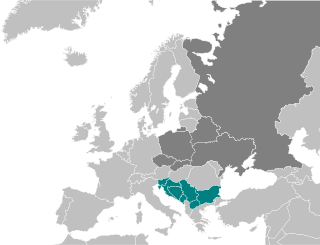
South Slavs are Slavic people who speak South Slavic languages and inhabit a contiguous region of Southeast Europe comprising the eastern Alps and the Balkan Peninsula. Geographically separated from the West Slavs and East Slavs by Austria, Hungary, Romania, and the Black Sea, the South Slavs today include Bosniaks, Bulgarians, Croats, Macedonians, Montenegrins, Serbs and Slovenes.
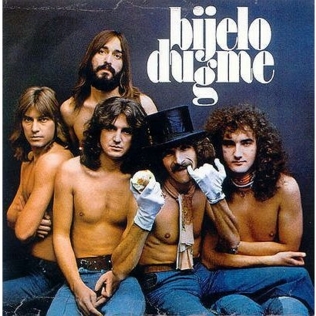
Bijelo Dugme was a Yugoslav rock band, formed in Sarajevo, SR Bosnia and Herzegovina in 1974. Bijelo Dugme is widely considered to have been the most popular band ever to exist in the former Socialist Federal Republic of Yugoslavia and one of the most notable acts of the Yugoslav rock scene and Yugoslav popular music in general.

Ćiribiribela is the ninth and final studio album by Yugoslav rock band Bijelo Dugme, released in 1988. Bijelo Dugme would split-up in 1989, and Ćirbiribela would be the band's last release before the band's 2005 reunion and the live album Turneja 2005: Sarajevo, Zagreb, Beograd.

Bijelo Dugme is the seventh studio album by Yugoslav rock band Bijelo Dugme, released in 1984. Due to Bijelo Dugme's usage of Uroš Predić's famous painting Kosovo Maiden for the album cover, the album is unofficially known as Kosovka djevojka.

Samo Tomášik, also known as Samuel Tomášik, pseudonyms Kozodolský, Tomášek; February 8, 1813 – September 10, 1887) was a Slovak romantic poet and prosaist.
The "National anthem of the Kingdom of Yugoslavia" was created in December 1918 from the national anthems of the Kingdom's three historical constituent lands: Kingdom of Croatia-Slavonia (Croatia), Kingdom of Serbia (Serbia) and Duchy of Carniola (Slovenia).
Below is a list of the forms of Slavic nationalism.

Yugoslavia was a state concept among the South Slavic intelligentsia and later popular masses from the 19th to early 20th centuries that culminated in its realization after the 1918 collapse of Austria-Hungary at the end of World War I and the formation of the Kingdom of Serbs, Croats and Slovenes. However, the kingdom was better known colloquially as Yugoslavia ; in 1929 it was formally renamed the "Kingdom of Yugoslavia".

Yugoslavism, Yugoslavdom, or Yugoslav nationalism is an ideology supporting the notion that the South Slavs, namely the Bosniaks, Croats, Macedonians, Montenegrins, Serbs and Slovenes, but also Bulgarians, belong to a single Yugoslav nation separated by diverging historical circumstances, forms of speech, and religious divides. During the interwar period, Yugoslavism became predominant in, and then the official ideology of the Kingdom of Yugoslavia. There were two major forms of Yugoslavism in the period: the regime favoured integral Yugoslavism promoting unitarism, centralisation, and unification of the country's ethnic groups into a single Yugoslav nation, by coercion if necessary. The approach was also applied to languages spoken in the Kingdom. The main alternative was federalist Yugoslavism which advocated the autonomy of the historical lands in the form of a federation and gradual unification without outside pressure. Both agreed on the concept of National Oneness developed as an expression of the strategic alliance of South Slavs in Austria-Hungary in the early 20th century. The concept was meant as a notion that the South Slavs belong to a single "race", were of "one blood", and had shared language. It was considered neutral regarding the choice of centralism or federalism.

The flag of Yugoslavia was the official flag of the Yugoslav state from 1918 to 1992. The flag's design and symbolism are derived from the Pan-Slavic movement, which ultimately led to the unification of the South Slavs and the creation of a united south-Slavic state in 1918.

Grlica was the first serial publication published in Montenegro. It was published from 1835 to 1839 in Cetinje, and was largely edited by Dimitrije Milaković, personal secretary of Prince-Bishop Petar II Petrović-Njegoš. It served as both a calendar, as well as an almanach, and was primarily aimed at the youth. Heavily influenced by Romanticism, Grlica was similar in content and purpose to Vuk Karadžić's Danica and ideas of Pan-Slavism and Yugoslavism were common themes.


















